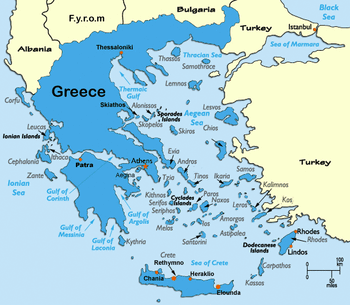Zante
| Author: Laxman Burdak, IFS (R). |

Zante or Zakynthos is a Greek island in the Ionian Sea. It is the third largest of the Ionian Islands. Zakynthos is a separate regional unit of the Ionian Islands region, and its only municipality. The Jats occupied this area and gave name to it Zouti/Zonti. [1]
Variants of name
- Zante (Greek: Τζάντε, Tzánte /ˈzɑːnti, -teɪ, ˈzæn-)
- Zakynthos (Greek: Ζάκυνθος, Zákynthos [ˈzacinθos] ,
- Zacìnto or Zante (Italian)
- Zouti/Zonti (Thakur Deshraj[2])
Location
Zakynthos is a separate regional unit of the Ionian Islands region, and the only municipality of the regional unit. The seat of administration is Zakynthos, the main town of the island. It covers an area of 405.55 km2 and its coastline is roughly 123 km in length.
Origin of name
The name, like all similar names ending in -nthos, is pre-Mycenaean or Pelasgian in origin. In Greek mythology the island was said to be named after Zakynthos, the son of a legendary Arcadian chief Dardanus.
History
Zakynthos is a tourist destination, with an international airport served by charter flights from northern Europe. The island's nickname is "The flower of the Levant", bestowed upon it by the Venetians who were in possession of Zakynthos from 1484–1797
The history of Zakynthos is long and complex, even by Greek standards. After the fall of the Byzantine Empire, it has been held by Naples, the Ottoman Turks, Venice, the French, Russians, British, Italians and Germans.
The ancient Greek poet Homer mentioned Zakynthos in the Iliad and the Odyssey, stating that its first inhabitants were the son of King Dardanos of Arcadia, called Zakynthos, and his men.Before being renamed Zakynthos, the island was said to have been called Hyrie. Zakynthos was then conquered by King Arkesios of Kefalonia, and then by Odysseus from Ithaca. Zakynthos participated in the Trojan War and is listed in the Homeric Catalogue of Ships which, if accurate, describes the geopolitical situation in early Greece at some time between the Late Bronze Age and the eighth century BCE. In the Odyssey, Homer mentions 20 nobles from Zakynthos among a total of 108 of Penelope's suitors.[3]
The Athenian military commander Tolmides concluded an alliance with Zakynthos during the First Peloponnesian War sometime between 459 and 446 BC. In 430 BC, the Lacedaemonians made an unsuccessful attack upon Zakynthos. The Zakynthians are then enumerated among the autonomous allies of Athens in the disastrous Sicilian expedition. After the Peloponnesian War, Zakynthos seems to have passed under the supremacy of Sparta because in 374 BC, Timotheus, the Athenian commander, on his return from Kerkyra, landed some Zakynthian exiles on the island and assisted them in establishing a fortified post. These exiles must have belonged to the anti-Spartan party as the Zakynthian rulers applied for help to the Spartans who sent a fleet of 25 to the island.[4][5][6]
The importance of this alliance for Athens was that it provided them with a source of tar. Tar is a more effective protector of ship planking than pitch (which is made from pine trees). The Athenian trireme fleet needed protection from rot, decay and the teredo, so this new source of tar was valuable to them. The tar was dredged up from the bottom of a lake (now known as Lake Keri) using leafy myrtle branches tied to the ends of poles. It was then collected in pots and could be carried to the beach and swabbed directly onto ship hulls.[7] Alternatively, the tar could be shipped to the Athenian naval yard at the Piraeus for storage.[8]
Philip V of Macedon seized Zakynthos in the early 3rd century BC when it was a member of the Aetolian League. In 211 BC, the Roman praetor Marcus Valerius Laevinus took the city of Zakynthos with the exception of the citadel. It was afterwards restored to Philip V of Macedon. The Roman general, Marcus Fulvius Nobilior, finally conquered Zakynthos in 191 BC for Rome. In the Mithridatic War, it was attacked by Archelaus, the general of Mithridates, but he was repulsed.[9]
जाट इतिहास
विश्व विजय सिकन्दर के देश ग्रीस में भी जाटों ने अपना उपनिवेश स्थापित किया था, यद्यपि इस समय ग्रीस में उनका अस्तित्व नहीं पाया जाता, किन्तु उसके मोरिया (Morea) के निकट ज्यूटी (Zouti) द्वीप के निवासी जाटों के उत्तराधिकारी हैं।[10]
References
- ↑ Jat History Thakur Deshraj/Chapter VI,p.194
- ↑ Jat History Thakur Deshraj/Chapter VI,p.194
- ↑ Smith, William (1854). Dictionary of Greek and Roman Geography. John Murray.
- ↑ Thucydides. History of the Peloponnesian War. Richard Crawley(trans). 2.8.
- ↑ Diodorus Siculus (1946). Library of History. 4. C.H. Oldfather (trans). Loeb Classical Library. 11.84.7. ISBN 978-0-674-99413-3. Retrieved 24 July 2010.
- ↑ Smith, William (1854). Dictionary of Greek and Roman Geography. John Murray.
- ↑ Herodotus (1910). History of Herodotus. George Rawlinson (trans). 4.195.
- ↑ Hale, John (2009). Lords of the Sea: The Epic Story of the Athenian Navy and the Birth of Democracy. New York: Viking. p. 107. ISBN 978-0-670-02080-5.
- ↑ Smith, William (1854). Dictionary of Greek and Roman Geography. John Murray.
- ↑ Jat History Thakur Deshraj/Chapter VI,p.194
Back to Jat Places in Greece

